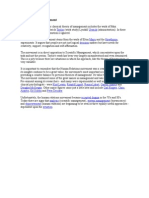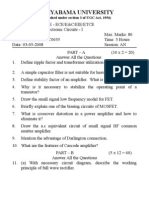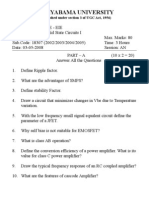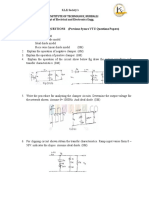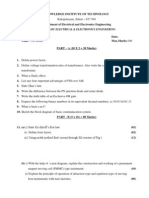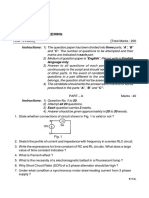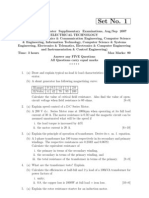0%(1)0% found this document useful (1 vote)
253 viewsEC 2205 Electronic Circuits I Nov-Dec 2013 Question Paper
EC 2205 Electronic Circuits I Nov-Dec 2013 Question Paper
Uploaded by
vishnu.kvlvThis document contains a question paper for an Electronics and Communication Engineering exam from November/December 2013. It has two parts:
Part A contains 10 short answer questions worth 2 marks each about electronic circuits topics like the Q point, thermal stability, Darlington amplifiers, amplifier characteristics, and rectifier concepts.
Part B contains 5 longer answer questions worth 16 marks each involving circuit analysis and explanations. The questions cover topics such as biasing circuits, amplifier configurations, transistor models, classes of amplifiers, and power supplies.
Copyright:
© All Rights Reserved
Available Formats
Download as PDF, TXT or read online from Scribd
EC 2205 Electronic Circuits I Nov-Dec 2013 Question Paper
EC 2205 Electronic Circuits I Nov-Dec 2013 Question Paper
Uploaded by
vishnu.kvlv0%(1)0% found this document useful (1 vote)
253 views2 pagesThis document contains a question paper for an Electronics and Communication Engineering exam from November/December 2013. It has two parts:
Part A contains 10 short answer questions worth 2 marks each about electronic circuits topics like the Q point, thermal stability, Darlington amplifiers, amplifier characteristics, and rectifier concepts.
Part B contains 5 longer answer questions worth 16 marks each involving circuit analysis and explanations. The questions cover topics such as biasing circuits, amplifier configurations, transistor models, classes of amplifiers, and power supplies.
Original Description:
ec 1
Copyright
© © All Rights Reserved
Available Formats
PDF, TXT or read online from Scribd
Share this document
Did you find this document useful?
Is this content inappropriate?
This document contains a question paper for an Electronics and Communication Engineering exam from November/December 2013. It has two parts:
Part A contains 10 short answer questions worth 2 marks each about electronic circuits topics like the Q point, thermal stability, Darlington amplifiers, amplifier characteristics, and rectifier concepts.
Part B contains 5 longer answer questions worth 16 marks each involving circuit analysis and explanations. The questions cover topics such as biasing circuits, amplifier configurations, transistor models, classes of amplifiers, and power supplies.
Copyright:
© All Rights Reserved
Available Formats
Download as PDF, TXT or read online from Scribd
Download as pdf or txt
0%(1)0% found this document useful (1 vote)
253 views2 pagesEC 2205 Electronic Circuits I Nov-Dec 2013 Question Paper
EC 2205 Electronic Circuits I Nov-Dec 2013 Question Paper
Uploaded by
vishnu.kvlvThis document contains a question paper for an Electronics and Communication Engineering exam from November/December 2013. It has two parts:
Part A contains 10 short answer questions worth 2 marks each about electronic circuits topics like the Q point, thermal stability, Darlington amplifiers, amplifier characteristics, and rectifier concepts.
Part B contains 5 longer answer questions worth 16 marks each involving circuit analysis and explanations. The questions cover topics such as biasing circuits, amplifier configurations, transistor models, classes of amplifiers, and power supplies.
Copyright:
© All Rights Reserved
Available Formats
Download as PDF, TXT or read online from Scribd
Download as pdf or txt
You are on page 1of 2
Question Paper Code : 31355
B.E./B.Tech. DEGREE EXAMINATION, NOVEMBERJDECEMBER 2013.
Third Semester
Electronics and Communication Engineering
EC 2205/EC 36/080290011 - ELECTRONIC CIRCUITS I
(Regulation 2008)
Time : Three hours Maximum: 100 marks
Answer ALL questions.
PART A (10 x 2 20 marks)
1. What is the function of the Q point?
2. What is thermal stability?
3. What is the advantage of Darlington amplifier?
4. Mention two important characteristics of CC circuit.
5. Define amplifier rise time.
6. Define bandwidth of an amplifier.
7. What is class C amplifier?
8. Define conversion efficiency.
9. Define ripple factor of a rectifier.
10. What is the function of a current limiting circuit?
PART B (5 x 16 = 80 marks)
11. (a) (i) Draw the circuit of a voltage divider bias circuit. Explain its operation and discuss
how it stabilizes against VBE changes. (8)
(ii) Derive the stability factor of the voltage divider bias circuit.
Compare the stability factor of fixed bias and voltage divider bias
circuits with hFE 100, Re = I Kohm, R1 = 33Kohm and R2 = 12 Kohms. (8)
Or
(b) (i) Explain the circuit of gate bias for providing tabilization of
JFET. (8)
(ii) Sketch the bias circuit for enhancement MOSFETs and explain its operation. (8)
12. (a) Draw the circuit of a CE amplifier with coupling and bypass capacitors. With the help
of its equivalent circuit, obtain the equation of the voltage gain, input and output impedance.
(16)
Or
(b) V Draw the circuit of a emitter coupled BJT differential amplifier and explain the
operation of the circuit. Explain how the differential amplifier
with a constant current stage improves the CMRR. (16)
13. (a) (i) V Sketch the hybrid r model of the V transistor and explain the function of each
parameter in the model. (8)
(ii) Study the behavior of the CE amplifier with resistive load at high frequencies and obtain
upper cut frequency and bandwidth. (8)
Or
www.Vidyarthiplus.com
www.Vidyarthiplus.com
(b) Draw the circuit diagram of a multi stage CE amplifier and obtain the frequency response
of the circuit. (16)
14. (a) (i) Draw and explain the circuit of a direct coupled class A amplifier. Obtain its
conversion efficiency. (8)
(ii) Draw the circuit of a transformer coupled class A amplifier and explain how conversion
efficiency is improved using the circuit. (8)
Or
(b) (i) Draw the circuit of a Class B push pull amplifier circuit and explain its operation.
Derive its conversion efficiency. (8)
(ii) Explain the operation of a complementary symmetry Class B amplifier and explain its
advantages. (8)
15. (a) (i) Draw and explain the circuit of a full wave rectifier with resistive load. (8)
(ii) Explain the use of the C and LC filters for improving the performance of the circuit. (8)
Or
(b) (i) Describe the principle of operation of zener diode voltage regulator. (8)
(ii) Explain with diagrams, how power control is achieved using SCR. (8)
www.Vidyarthiplus.com
www.Vidyarthiplus.com
You might also like
- LGMG Mining Machinery BrochureDocument18 pagesLGMG Mining Machinery BrochureErol Da Costa100% (1)
- Human Relations MovementDocument1 pageHuman Relations MovementMuhammad Sadiq VighioNo ratings yet
- ECAD Question BankDocument5 pagesECAD Question Bank20BF1A04M6 sumanthNo ratings yet
- Anna University - Chennai B.E./B.Tech - Degree-Examination-December 2009 Third Semester-Electronics &communications Engg. Electronic Circuits-IDocument1 pageAnna University - Chennai B.E./B.Tech - Degree-Examination-December 2009 Third Semester-Electronics &communications Engg. Electronic Circuits-Iselvaece2010No ratings yet
- Instruction To CandidatesDocument2 pagesInstruction To CandidatesAnmolNo ratings yet
- Jntuworld: R07 Set No. 2Document5 pagesJntuworld: R07 Set No. 2Kasarla Shiva SjNo ratings yet
- Electronic Devices Circuits2Document1 pageElectronic Devices Circuits2Shaik BawajanNo ratings yet
- Answer Any Two Full Questions, Each Carries 15 Marks.: Reg No.: - NameDocument2 pagesAnswer Any Two Full Questions, Each Carries 15 Marks.: Reg No.: - Namesheena mNo ratings yet
- Ese 88Document8 pagesEse 88Prasanna KumarNo ratings yet
- EC! - Nov Dec 2009Document3 pagesEC! - Nov Dec 2009Sumathy SubramanianNo ratings yet
- Sathyabama University: (Established Under Section 3 of UGC Act, 1956)Document4 pagesSathyabama University: (Established Under Section 3 of UGC Act, 1956)Joshua prabuNo ratings yet
- Sathyabama University: (Established Under Section 3 of UGC Act, 1956)Document3 pagesSathyabama University: (Established Under Section 3 of UGC Act, 1956)Joshua prabuNo ratings yet
- Btech 2nd Year Question PaperDocument32 pagesBtech 2nd Year Question PaperPolireddi Gopala KrishnaNo ratings yet
- Power Electronics Important QuestionsDocument2 pagesPower Electronics Important QuestionsNandish NNo ratings yet
- Ec 254 Electronic CircuitsDocument2 pagesEc 254 Electronic CircuitsKARTHIKEYAN100% (2)
- Edc 7Document8 pagesEdc 729viswa12100% (1)
- ECMODELSEP11Document1 pageECMODELSEP11Antony RajaNo ratings yet
- AEC BankDocument9 pagesAEC BankprakashkerurNo ratings yet
- EC I EC2205 University Ques BankDocument14 pagesEC I EC2205 University Ques Bankkamalsrec78No ratings yet
- Edc 4Document10 pagesEdc 429viswa12No ratings yet
- 1st Year Que NewDocument3 pages1st Year Que Newbalusasi_skgNo ratings yet
- QB For Ec-IDocument7 pagesQB For Ec-IklnayaagiNo ratings yet
- Graph Sheets May Be Supplied On Demand: Page 1 of 2Document2 pagesGraph Sheets May Be Supplied On Demand: Page 1 of 2sarang acNo ratings yet
- Ge2151 Basic Electrical and Electronics EngineeringDocument4 pagesGe2151 Basic Electrical and Electronics EngineeringNithin PurandharNo ratings yet
- KTU EC205 ELECTRONIC CIRCUITS (AE, EC) - MAin - Jan - 2017 - Ktu Qbank-MergedDocument16 pagesKTU EC205 ELECTRONIC CIRCUITS (AE, EC) - MAin - Jan - 2017 - Ktu Qbank-MergedsunNo ratings yet
- Basic Electrical EngineeringDocument2 pagesBasic Electrical EngineeringsanththaNo ratings yet
- Answer Any Two Full Questions, Each Carries 15 Marks.: Page 1 of 2Document2 pagesAnswer Any Two Full Questions, Each Carries 15 Marks.: Page 1 of 2sheena mNo ratings yet
- SEE QUESTION BANK Final_copyDocument4 pagesSEE QUESTION BANK Final_copy1nh21ee035No ratings yet
- Set No. 1: CEO CBODocument9 pagesSet No. 1: CEO CBO29viswa12No ratings yet
- Ec (Ee) 301Document1 pageEc (Ee) 301main2510No ratings yet
- 2019 Dec. EE203-H - Ktu QbankDocument2 pages2019 Dec. EE203-H - Ktu QbankFarooq KhandayNo ratings yet
- 1 Ec205 Electronic Circuits (Ae, Ec)Document2 pages1 Ec205 Electronic Circuits (Ae, Ec)ABHILESH G KNo ratings yet
- Ec I Model QPDocument3 pagesEc I Model QPNoddy SenNo ratings yet
- United International University (Uiu)Document4 pagesUnited International University (Uiu)Masud SarkerNo ratings yet
- EDC QuestionDocument5 pagesEDC QuestionSampath KumarNo ratings yet
- Electrical Engineering: Instructions: 1) The Question Paper Has Been Divided Into Three Parts, "A", "B"Document4 pagesElectrical Engineering: Instructions: 1) The Question Paper Has Been Divided Into Three Parts, "A", "B"Miral_KagathraNo ratings yet
- IcappDocument6 pagesIcappSurya TejaNo ratings yet
- Electronics Circuit AnalysisDocument8 pagesElectronics Circuit AnalysisrpramkmrNo ratings yet
- WWW - Manaresults.Co - In: II B. Tech I Semester Regular Examinations, Jan - 2015 Electronic Devices and CircuitsDocument4 pagesWWW - Manaresults.Co - In: II B. Tech I Semester Regular Examinations, Jan - 2015 Electronic Devices and CircuitsUr's Lovely NagNo ratings yet
- Microwave EngineeringDocument5 pagesMicrowave EngineeringHarikrishna KhariduNo ratings yet
- Electronic Circuits IDocument1 pageElectronic Circuits ISarika VadivelanNo ratings yet
- Question Paper Code:: Reg. No.Document3 pagesQuestion Paper Code:: Reg. No.Ruban PonrajNo ratings yet
- Electrical and Electronics EngineeringDocument6 pagesElectrical and Electronics EngineeringsrihariNo ratings yet
- IES 1988 Question PaperpdfDocument8 pagesIES 1988 Question Paperpdfh9emanth4No ratings yet
- EE 2251 - ELECTRICAL MACHINES - I Nov - Dec 2011Document2 pagesEE 2251 - ELECTRICAL MACHINES - I Nov - Dec 2011madhes14No ratings yet
- EC 1 Important Questions WordDocument10 pagesEC 1 Important Questions WordhanifathariqNo ratings yet
- Question Bank (EJ/IE/IS3G) EDC (17319)Document4 pagesQuestion Bank (EJ/IE/IS3G) EDC (17319)kadaNo ratings yet
- EDC Question-Papers Complete SetDocument13 pagesEDC Question-Papers Complete Setselvi04120% (1)
- X10401 (Ee8552)Document3 pagesX10401 (Ee8552)Sujesh ChittarikkalNo ratings yet
- Rr220402 Electrical TechnologyDocument8 pagesRr220402 Electrical TechnologySrinivasa Rao GNo ratings yet
- Nov 2011Document2 pagesNov 2011RAJARAMNo ratings yet
- Kings: Subject Code: EC1203 Subject Name: Electronic Circuits - I Year/Sem: II/IIIDocument5 pagesKings: Subject Code: EC1203 Subject Name: Electronic Circuits - I Year/Sem: II/IIIEASACOLLEGENo ratings yet
- 07a81001 IndustrialelectronicsDocument6 pages07a81001 IndustrialelectronicsSharanya ThirichinapalliNo ratings yet
- B.Tech. III Year I Semester Regular / Supplementary Examinations, Nov/Dec, 2018Document2 pagesB.Tech. III Year I Semester Regular / Supplementary Examinations, Nov/Dec, 2018Namaswini SureshNo ratings yet
- JNTUK May June 2015-2-2 R13 Electronic Circuit Analysis Common To ECE EIEDocument5 pagesJNTUK May June 2015-2-2 R13 Electronic Circuit Analysis Common To ECE EIEJaswanth PatnaikNo ratings yet
- C1EC01-C1405 - ELECTRONIC CIRCUIT ANALYSIS & DESIGN MergedDocument18 pagesC1EC01-C1405 - ELECTRONIC CIRCUIT ANALYSIS & DESIGN Mergedchini_naniNo ratings yet
- Power System Transient Analysis: Theory and Practice using Simulation Programs (ATP-EMTP)From EverandPower System Transient Analysis: Theory and Practice using Simulation Programs (ATP-EMTP)No ratings yet
- Fundamentals of Electronics 1: Electronic Components and Elementary FunctionsFrom EverandFundamentals of Electronics 1: Electronic Components and Elementary FunctionsNo ratings yet
- VSC-FACTS-HVDC: Analysis, Modelling and Simulation in Power GridsFrom EverandVSC-FACTS-HVDC: Analysis, Modelling and Simulation in Power GridsNo ratings yet
- Anti-Lock Brake System (ABS) : Workshop ManualDocument87 pagesAnti-Lock Brake System (ABS) : Workshop ManualRowan Cornelius100% (1)
- Operators Manual: Caliber .40 S&WDocument13 pagesOperators Manual: Caliber .40 S&Wakms1982No ratings yet
- 11S ME304 MT2 SolutionsDocument6 pages11S ME304 MT2 SolutionsOğulcan AytaçNo ratings yet
- JDocument28 pagesJBaso Syahrul AkramNo ratings yet
- MCA Lab Manual NewDocument18 pagesMCA Lab Manual Newkummara karthikNo ratings yet
- Product CatalogueDocument40 pagesProduct CataloguePeteris SkelsNo ratings yet
- Module Reviewer (Module 2)Document34 pagesModule Reviewer (Module 2)Omar AculanNo ratings yet
- Concept of Bonus in India and Its ProtectionDocument4 pagesConcept of Bonus in India and Its Protection9415697349No ratings yet
- Catalogue: Voice Alarm Control and Indicating Equipment (VACIE)Document208 pagesCatalogue: Voice Alarm Control and Indicating Equipment (VACIE)christianxlaNo ratings yet
- Assignment/ Tugasan - Human Resource DevelopmentDocument5 pagesAssignment/ Tugasan - Human Resource DevelopmentIna RawaNo ratings yet
- Informal Land Market in Peri-UrbanDocument24 pagesInformal Land Market in Peri-UrbanAhmed MussaNo ratings yet
- Course Syllabus Marketing Management MKT377 3 CreditsDocument6 pagesCourse Syllabus Marketing Management MKT377 3 CreditsToulouse18No ratings yet
- Amg ResumeDocument3 pagesAmg ResumeSivashankar DhanarajNo ratings yet
- ASM Material Data Sheet (Aluminium Beam)Document2 pagesASM Material Data Sheet (Aluminium Beam)Mohammed AdnanNo ratings yet
- Caregiver Resume SkillsDocument6 pagesCaregiver Resume Skillsc2qaz2p3100% (1)
- Discharges May 1-2, 2016Document26 pagesDischarges May 1-2, 2016Lenrick BancilNo ratings yet
- Downloaded From Manuals Search EngineDocument10 pagesDownloaded From Manuals Search EngineDavid QuispeNo ratings yet
- Data Transfer TechniquesDocument33 pagesData Transfer TechniquesPRASHANT KUMARNo ratings yet
- CabletecDocument4 pagesCabletecLiang ZhangNo ratings yet
- 1 X TRIGON L Plus Boiler LLH 1CT Heating Circuit 1 DHW Circuit With A CalorifierDocument4 pages1 X TRIGON L Plus Boiler LLH 1CT Heating Circuit 1 DHW Circuit With A Calorifieradyro12No ratings yet
- NomnuudDocument16 pagesNomnuudBilegee KhNo ratings yet
- 【Parfums Christian Dior】JD - DX Project ManagerDocument2 pages【Parfums Christian Dior】JD - DX Project ManagerjeffNo ratings yet
- MineralWoolInsulation Data SheetDocument18 pagesMineralWoolInsulation Data SheetAnonymous MB5YbaLrBENo ratings yet
- Why You Will Marry The Wrong Person & Other EssaysDocument7 pagesWhy You Will Marry The Wrong Person & Other EssaysHanna SyabrinaNo ratings yet
- Critical ThinkingDocument4 pagesCritical Thinkingpanamajack26No ratings yet
- Audio Recording SystemDocument2 pagesAudio Recording SystemDarko IlicNo ratings yet
- 4r100 Plano de La CajaDocument12 pages4r100 Plano de La CajaproyectorodrigoleonNo ratings yet
- Deep Change: Robert E. QuinnDocument4 pagesDeep Change: Robert E. Quinntyrob86100% (2)

